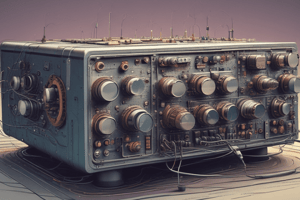Podcast
Questions and Answers
What is one advantage of using a bus network for instrumentation compared to hardwiring each device?
What is one advantage of using a bus network for instrumentation compared to hardwiring each device?
- It prevents any potential signal interference.
- It guarantees higher data accuracy.
- It allows for analog signals only.
- It reduces the amount of physical wiring needed. (correct)
What is one example of a proprietary bus network mentioned in the content?
What is one example of a proprietary bus network mentioned in the content?
- Wi-Fi
- Modbus Plus (correct)
- TCP/IP
- Ethernet
What was a significant challenge during the bus wars of the late eighties and early nineties?
What was a significant challenge during the bus wars of the late eighties and early nineties?
- Developing a universal bus standard.
- Establishing a cost-effective wiring system.
- Deciding on the best type of sensor for data acquisition.
- Integrating various proprietary buses from different vendors. (correct)
What range of input current can be categorized as an analog input?
What range of input current can be categorized as an analog input?
What is the main advantage of devices on a bus network having a node address?
What is the main advantage of devices on a bus network having a node address?
What primary function does a wireless sensor network serve in a monitoring system?
What primary function does a wireless sensor network serve in a monitoring system?
Which of the following best describes the typical topology used in wireless sensor networks mentioned?
Which of the following best describes the typical topology used in wireless sensor networks mentioned?
What is a significant risk associated with wireless sensor networks?
What is a significant risk associated with wireless sensor networks?
In the context of a controller, how is a value read from an instrument classified?
In the context of a controller, how is a value read from an instrument classified?
What action might an operator take that is considered an input to a controller?
What action might an operator take that is considered an input to a controller?
What is one limitation of using wireless sensor networks for feedback control?
What is one limitation of using wireless sensor networks for feedback control?
Which of the following statements is true regarding the usage of wireless sensors?
Which of the following statements is true regarding the usage of wireless sensors?
Flashcards are hidden until you start studying
Study Notes
Inputs to Controllers
- Digital inputs mapped to memory as binary states (0 or 1) based on device status (e.g., ON/OFF).
- Analog inputs can vary and may include ranges like 4-20 mA or -10 to +10 mV.
- Bus networks reduce the need for hardwired connections, allowing multiple instruments to connect on a single trunk line.
Types of Bus Networks
- Examples include Hart, Profibus, Foundation Fieldbus, Modbus Plus, and ControlNet.
- Late 1980s to early 1990s saw competition among various proprietary bus formats, similar to technology battles like Beta vs. VHS.
- Ethernet gained popularity due to reduced costs of Ethernet cards compared to proprietary buses, leading to increased integration challenges for system integrators.
Functionality of Bus Networks
- Each device on a bus has a unique node address.
- Sensors convert analog values to digital within themselves, reducing the need for transmission back to PLC for conversion.
- Each sensor node can store multiple memory addresses for different monitoring variables.
Wireless Sensor Networks
- Ideal for applications like tank monitoring, allowing multiple sensors without extensive cabling.
- Typically use mesh topology and protocols like ZigBee, ISA 100, or Wireless HART.
- Generally suited for continuous monitoring, not for closed-loop feedback control due to potential security vulnerabilities (e.g., jamming, spoofing).
Operator Interaction
- Operators can adjust set points for processes via user interfaces.
- Changes made by operators are treated as inputs to the PLC, influencing control outputs (e.g., adjusting valve status, pump speed).
- Understanding inputs and outputs from the PLC's perspective is essential: instrument data as inputs, control commands sent out as outputs.
Summary of Input Types
- Various inputs to a PLC include:
- Digital inputs (discrete states)
- Analog inputs (continuous signals)
- Bus network inputs (multiple data channels)
- Wireless sensor inputs (remote monitoring)
- Operator adjustments to set points (operator-induced inputs)
Studying That Suits You
Use AI to generate personalized quizzes and flashcards to suit your learning preferences.




